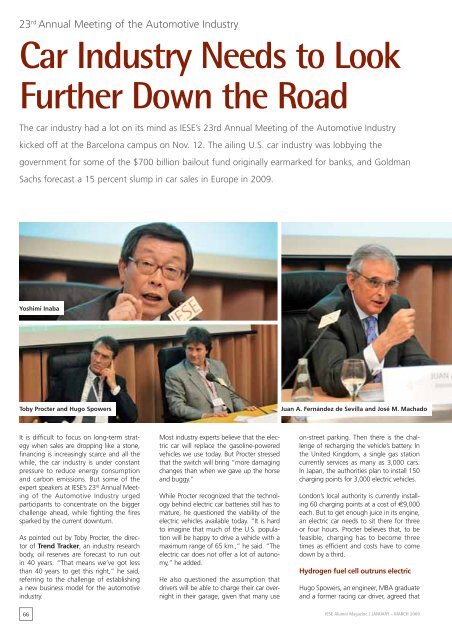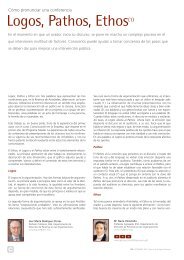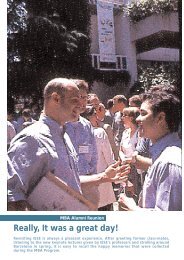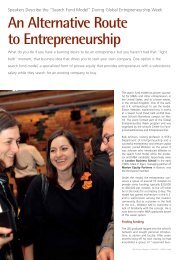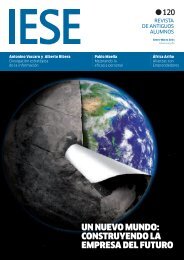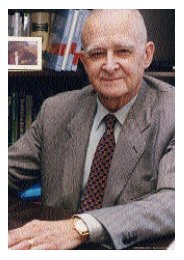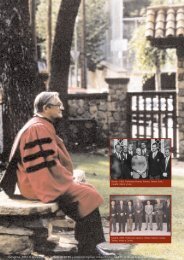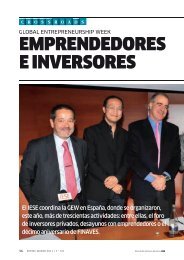Alumni Magazine - revista iese.
Alumni Magazine - revista iese.
Alumni Magazine - revista iese.
Create successful ePaper yourself
Turn your PDF publications into a flip-book with our unique Google optimized e-Paper software.
23 rd Annual Meeting of the Automotive Industry<br />
Car Industry Needs to Look<br />
Further Down the Road<br />
The car industry had a lot on its mind as IESE’s 23rd Annual Meeting of the Automotive Industry<br />
kicked off at the Barcelona campus on Nov. 12. The ailing U.S. car industry was lobbying the<br />
government for some of the $700 billion bailout fund originally earmarked for banks, and Goldman<br />
Sachs forecast a 15 percent slump in car sales in Europe in 2009.<br />
Yoshimi Inaba<br />
Toby Procter and Hugo Spowers<br />
Juan A. Fernández de Sevilla and José M. Machado<br />
It is difficult to focus on long-term strategy<br />
when sales are dropping like a stone,<br />
financing is increasingly scarce and all the<br />
while, the car industry is under constant<br />
pressure to reduce energy consumption<br />
and carbon emissions. But some of the<br />
expert speakers at IESE’s 23 rd Annual Meeting<br />
of the Automotive Industry urged<br />
participants to concentrate on the bigger<br />
challenge ahead, while fighting the fires<br />
sparked by the current downturn.<br />
As pointed out by Toby Procter, the director<br />
of Trend Tracker, an industry research<br />
body, oil reserves are forecast to run out<br />
in 40 years. “That means we’ve got less<br />
than 40 years to get this right,” he said,<br />
referring to the challenge of establishing<br />
a new business model for the automotive<br />
industry.<br />
Most industry experts believe that the electric<br />
car will replace the gasoline-powered<br />
vehicles we use today. But Procter stressed<br />
that the switch will bring “more damaging<br />
changes than when we gave up the horse<br />
and buggy.”<br />
While Procter recognized that the technology<br />
behind electric car batteries still has to<br />
mature, he questioned the viability of the<br />
electric vehicles available today. “It is hard<br />
to imagine that much of the U.S. population<br />
will be happy to drive a vehicle with a<br />
maximum range of 65 km.,” he said. “The<br />
electric car does not offer a lot of autonomy,”<br />
he added.<br />
He also questioned the assumption that<br />
drivers will be able to charge their car overnight<br />
in their garage, given that many use<br />
on-street parking. Then there is the challenge<br />
of recharging the vehicle’s battery. In<br />
the United Kingdom, a single gas station<br />
currently services as many as 3,000 cars.<br />
In Japan, the authorities plan to install 150<br />
charging points for 3,000 electric vehicles.<br />
London’s local authority is currently installing<br />
60 charging points at a cost of €9,000<br />
each. But to get enough juice in its engine,<br />
an electric car needs to sit there for three<br />
or four hours. Procter believes that, to be<br />
feasible, charging has to become three<br />
times as efficient and costs have to come<br />
down by a third.<br />
Hydrogen fuel cell outruns electric<br />
Hugo Spowers, an engineer, MBA graduate<br />
and a former racing car driver, agreed that<br />
66 IESE <strong>Alumni</strong> <strong>Magazine</strong> / JANUARY - MARCH 2009


